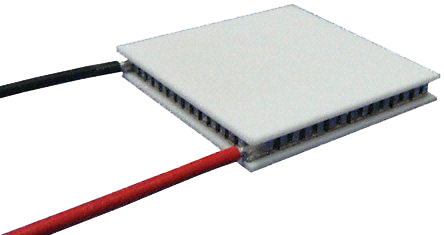The Benefits of Thermoelectric Cooling
While refrigerators and air conditioners utilize compressors, condensers, and liquid refrigerants to lower temperature, thermoelectrically cooled devices (like the ArTek Spot and ArTek Air) utilize DC power, heat sinks, and thermoelectric chips, or TECs. The ArTek Spot and ArTek Air systems contain arrays of TECs.
This fundamental difference gives solid-state thermoelectric coolers the following advantages over other methods of cooling:
- NO ICE REQUIRED FOR COOLING!
- They allow for very tight and accurate temperature control
- No moving parts. Therefore they require little or no maintenance. Ideal for cooling parts that may be sensitive to mechanical vibration.
- No refrigerants, such as potentially harmful CFCs. Therefore environmental and safety benefits.
- Enables reduced, low-noise operation of cooling fans, while providing greater cooling power.
- Allow for systems to be lightweight and compact due to their small size.
- Long life. Exceeds 100,000 hrs MTBF (Mean Time Between Failures).
- Controllable (by voltage / current).
- Fast, dynamic response.
- Can provide cooling below ambient temperature.

Thermoelectric coolers (TECs), also known as Peltier coolers, are solid-state heat pumps that utilize the Peltier effect to move heat. Passing a current though a TEC transfers heat from one side to the other, typically producing a heat differential of around 40°C—or as much as 70°C in high-end devices—that can be used to transfer heat from one place to another.
The principle of thermoelectric cooling dates back to the discovery of the Peltier Effect by Jean Peltier in 1834. All electric current is accompanied by heat current (Joule heating). What Peltier observed was that when electric current passed across the junction of two dissimilar conductors (a thermocouple) there was a heating effect that could not be explained by Joule heating alone. In fact, depending on the direction of the current, the overall effect could be either heating or cooling. This effect can be harnessed to transfer heat, creating a heater or a cooler.
 When two conductors are placed in electric contact, electrons flow out of the one in which the electrons are less bound, into the one where the electrons are more bound. Current passing across the junction results in either a forward or reverse bias, resulting in a temperature gradient; Cold vs. Heat! If the temperature of the hotter junction (heat sink) is kept low by removing the generated heat, the temperature of the cold plate can be cooled by tens of degrees.
When two conductors are placed in electric contact, electrons flow out of the one in which the electrons are less bound, into the one where the electrons are more bound. Current passing across the junction results in either a forward or reverse bias, resulting in a temperature gradient; Cold vs. Heat! If the temperature of the hotter junction (heat sink) is kept low by removing the generated heat, the temperature of the cold plate can be cooled by tens of degrees.
In practice many TEC pairs (or couples) are connected side-by-side,and sandwiched between two ceramic plates, in a single TEC unit.





